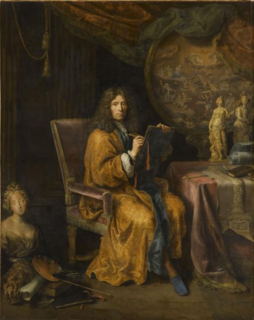Related Research Articles

Duccio di Buoninsegna was an Italian painter active in Siena, Tuscany, in the late 13th and early 14th century. He was hired throughout his life to complete many important works in government and religious buildings around Italy. Duccio is considered one of the greatest Italian painters of the Middle Ages, and is credited with creating the painting styles of Trecento and the Sienese school. He also contributed significantly to the Sienese Gothic style.

The Caravaggisti were stylistic followers of the late 16th-century Italian Baroque painter Caravaggio. His influence on the new Baroque style that eventually emerged from Mannerism was profound. Caravaggio never established a workshop as most other painters did, and thus had no school to spread his techniques. Nor did he ever set out his underlying philosophical approach to art, the psychological realism which can only be deduced from his surviving work. But it can be seen directly or indirectly in the work of Rubens, Jusepe de Ribera, Bernini, and Rembrandt. Famous while he lived, Caravaggio himself was forgotten almost immediately after his death. Many of his paintings were reascribed to his followers, such as The Taking of Christ, which was attributed to the Dutch painter Gerrit van Honthorst until 1990. It was only in the 20th century that his importance to the development of Western art was rediscovered. In the 1920s Roberto Longhi once more placed him in the European tradition: "Ribera, Vermeer, La Tour and Rembrandt could never have existed without him. And the art of Delacroix, Courbet and Manet would have been utterly different". The influential Bernard Berenson stated: "With the exception of Michelangelo, no other Italian painter exercised so great an influence."

Pierre Mignard or Pierre Mignard I, called "Mignard le Romain" to distinguish him from his brother Nicolas Mignard, was a French painter known for his religious and mythological scenes and portraits. He was a near-contemporary of the Premier Peintre du Roi Charles Le Brun with whom he engaged in a bitter, life-long rivalry.
Neo-expressionism is a style of late modernist or early-postmodern painting and sculpture that emerged in the late 1970s. Neo-expressionists were sometimes called Transavantgarde, Junge Wilde or Neue Wilden. It is characterized by intense subjectivity and rough handling of materials.

Andries Both, was a Dutch genre painter. He was part of the group of Dutch and Flemish genre painters active in Rome in the 17th century known as the bamboccianti, who painted scenes from the everyday life of the lower classes in Rome and its countryside.
Events from the year 1656 in art.

Giovanni Tuccari (1667–1743) was an Italian painter during the Baroque period, active in Sicily.

Francesco Vanni was an Italian painter, draughtsman, printmaker, publisher and printer active in Rome and his native city of Siena.
Events from the year 1580 in art.

Francesco Vecellio was an Italian painter of the early Renaissance, best known as the elder brother of the painter Titian. In his youth, he was a soldier. As a painter, he was mainly active in 1520-1530s in Cadore. In 1524, he signed an altarpiece for San Vito in Cadore. In 1540s, he painted a polyptych at Candide. In late 1540s he painted the organ shutters of San Salvatore in Venice. He painted an Annunciation for San Nicola di Bari, now in the Gallerie dell'Accademia, along with Madonna and Child with Saint Jerome and Saint Dorothy (Glasgow).
Events from the year 1657 in art.
Events from the year 1619 in art.
Events from the year 1660 in art.
Events from the year 1669 in art.
Events from the year 1607 in art.

Lazzaro Bastiani was an Italian painter of the Renaissance, active mainly in Venice.

Theophanis Strelitzas, also known as Theophanes the Cretan pronounced Theophanes O Krees or Theophanes Bathas. He was a Greek painter and educator. He painted icons and frescos. He was a member of a prominent family of painters Strelitzas-Bathas. The origin of the family was the Peloponnesus region. His son was famous painter Symeon Bathas Strelitzas. He was also his apprentice. Other important painters of the same name were Thomas Bathas and Markos Bathas. Another fresco painter of the same period was Fragkos Katelanos. Theophanes's family built the framework of the Cretan School. Over one hundred icons and frescos have survived. They can be found all over Greece. Theophanes influenced countless painters. Some of the painters were Fragkos Katelanos and Dionysius of Fourna. He was one of the most important fresco painters of the period.

Davide Ghirlandaio (1452–1525), also known as David Ghirlandaio and as Davide Bigordi, was an Italian painter and mosaicist, active in his native Florence.

The Phiale Painter, also known as Boston Phiale Painter, was a painter of the Attic red-figure style. He was active around 460 to 430 BC. The Phiale Painter is assumed to have been a pupil of the Achilles Painter. In contrast to his master, he liked to depict narrative scenes. He painted several large calyx kraters, often with two registers of figures; unlike his master, he seems to have preferred larger vessels in general. This is shown by his white-ground works, which are not well known, but more expressive than those of the Achilles Painter. Apart from a number of lekythoi, he painted two chalice kraters in white-ground technique, a rarity at the time. His themes may be partially influenced by contemporary theatre. His preferred name for kalos inscriptions is that of Euaion, son of Aeschylus. His conventional name is based on the fact that a painted phiale, a vase shape rarely equipped with figural depictions, is known from him.
References
- Bryan, Michael (1889). Walter Armstrong; Robert Edmund Graves (eds.). Dictionary of Painters and Engravers, Biographical and Critical. Vol. II L-Z. London: George Bell and Sons. p. 7.